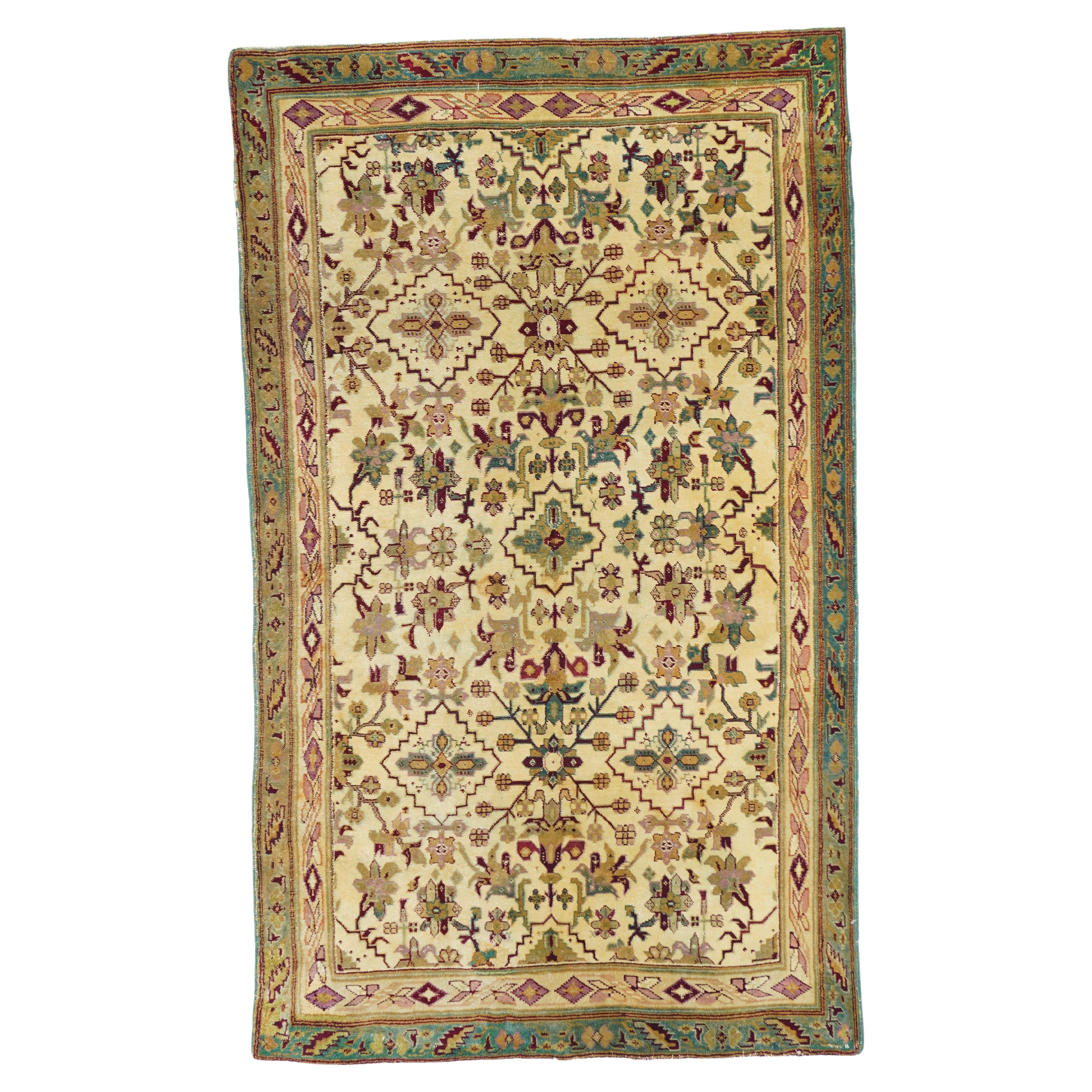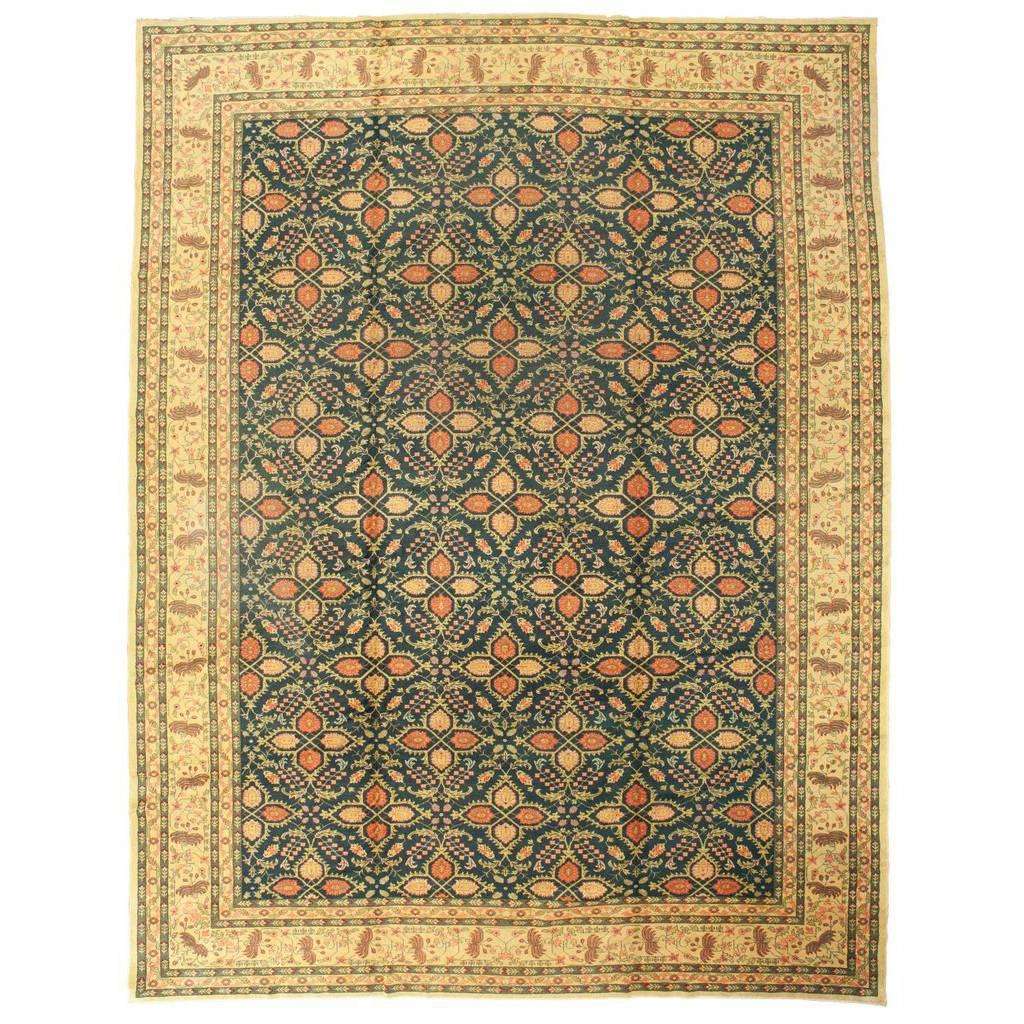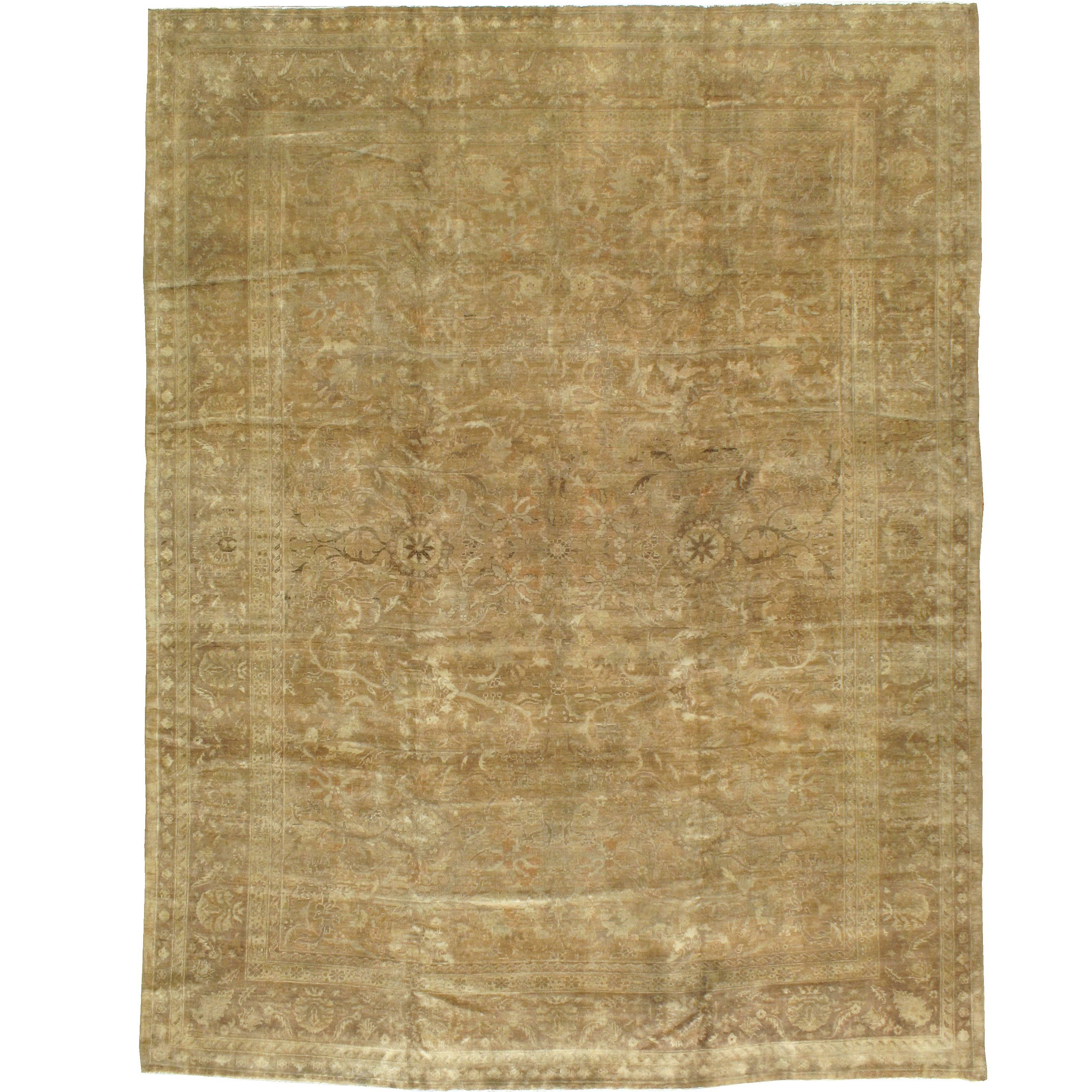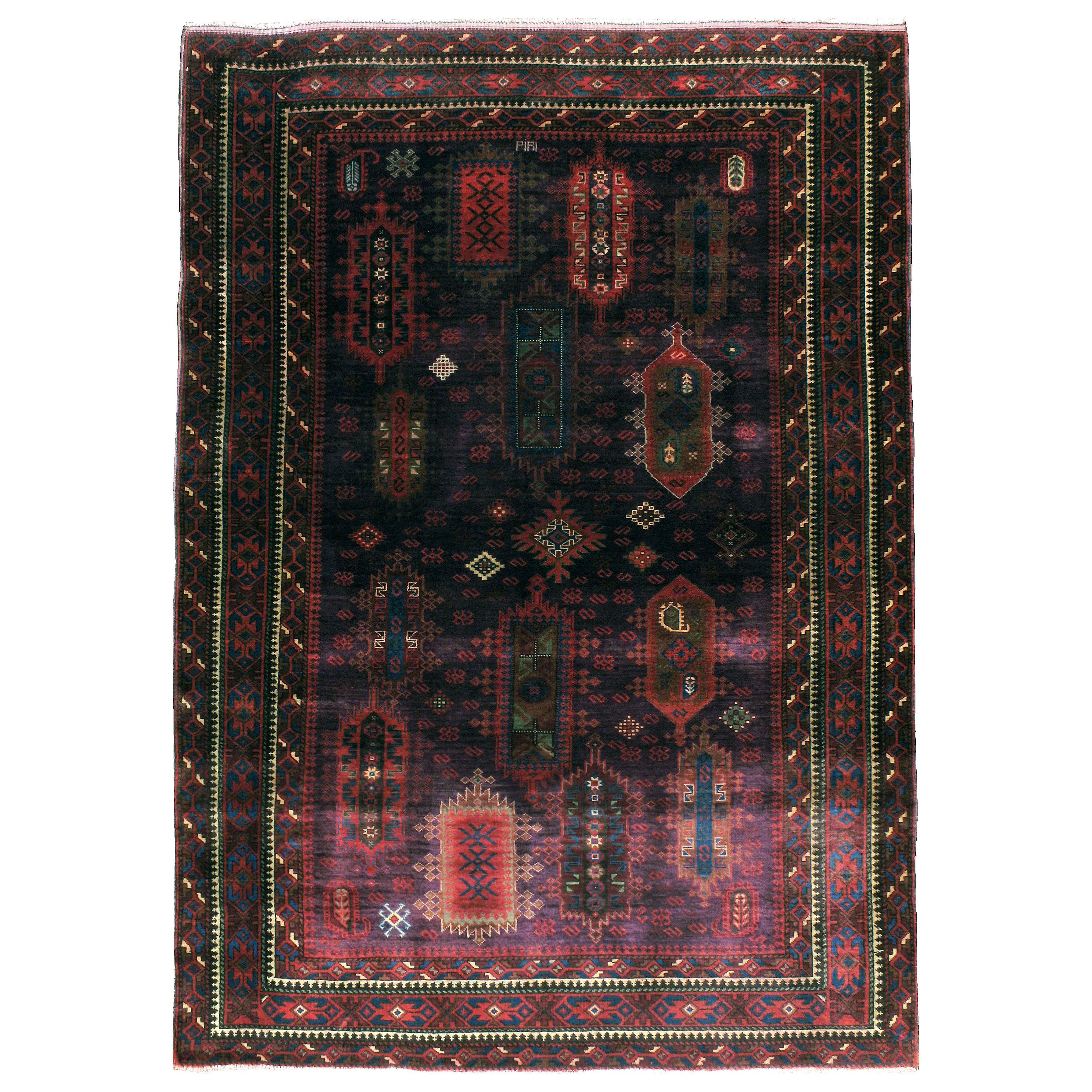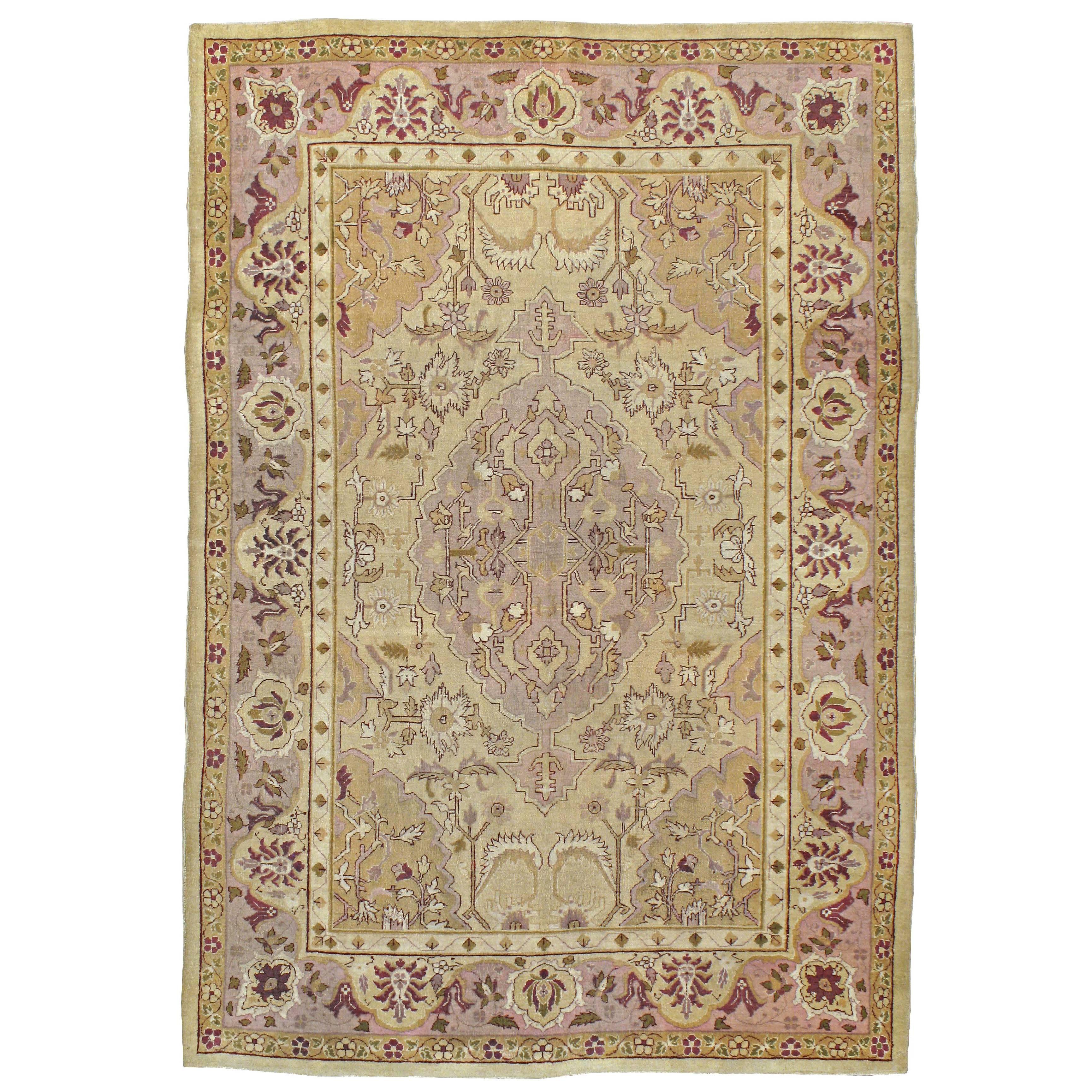Items Similar to Antique Agra Rug
Want more images or videos?
Request additional images or videos from the seller
1 of 8
Antique Agra Rug
About the Item
Agra - North India
This is a 120-year-old monumental Agra rug in excellent condition. This piece was inspired by the famous Persian rug, Ardabil, made in the 16th Century for the Persian court. The main field of the rug is woven in marsala. Sixteen pendants surround the central medallion and symbolise the sun’s fullness, radiating light over all the flowers across the carpet. Two lamps hanging from the central medallion’s axis illuminate this flower garden. The marsala field is covered in flowers and leaves intertwined in curvilinear patterns and spiral shapes. The artist created the floral patterns to produce a sense of time: some lotus flowers and Chinese peonies are still in blossom, while others are in full bloom. The flower design invades the border of the rug. These floral designs represent spring and all the allegories associated with rebirth and fertility. The lotus flowers along the border also symbolise rebirth, and the peonies symbolise power. Lastly, this Agra features the same inscription found in 16th-century Ardebil. The four-line inscription placed at one end of the rug is a poem by the famous Persian poet Hafiz. Below the poem, the rug is signed by its artist, Maqsoud Kachani, and is dated 946 (AD 1539-40). “I have no refuge in the world beyond your threshold. There is no protection for my head beyond this door. The work of court servant Maqsud of Kashan in the year 946.” This rug is a work of art with elements of Persian and Indian history, art and culture. The carpet is clean and ready for use.
Agra, famed for the Taj Mahal, has a rich carpet-making tradition. Agra ateliers have crafted exceptional antique carpets, which are celebrated for their artistry and finish. Unlike modern “Indian” rugs, antique and semi-antique Agra carpets are highly sought after and rank among the finest oriental carpets.
The pinnacle of 19th-century antique Indian carpets were crafted in Amritsar, north of Agra. These carpets are lauded for their extraordinary art, lustrous wool, artistic designs, and perfect colour combinations. Antique Amritsar rugs, especially those featuring well-defined, spaciously arranged “paradise” themes, are rarely found and highly prized for their grandeur and decorative impact.
Carpet weaving in Agra dates back to the Mughal Empire’s establishment in 1530. The Mughal emperors, profoundly influenced by Persian art and culture, aimed to emulate the Persian court’s beauty. The resulting “Mughal” carpets were creative masterpieces and precursors to today’s antique Agra carpets.
In 1584, the third Mughal emperor, Akbar the Great, established his capital in Agra, where his grandson, Shah Jahan, later built the Taj Mahal. Records from Akbar’s reign attest to the court’s patronage of antique carpet weaving, with Persian craftsmen invited to India to help establish the carpet industry.
Agra carpets blend the grandeur and beauty of renowned antique Persian court carpet designs with motifs symbolic of Indian culture. Persian spiral vine designs often combine with small animal figures, including birds, elephants, lions, or humans. A famous Agra carpet design for the Mughal emperors consisted of rows of flowers in pots, a design later adopted by the Persians.
Agra weavers, masters of vegetable dyeing, developed a unique colour palette, including soft blues, a profusion of gold, a range from rust red to pink, and a lavender shade not found in other carpets. These colours lend Agra carpets a light, ethereal appearance that leaves a lasting impression.
While 20th-century Agra carpets often lack the quality and inspiration of their predecessors, the finest 19th-century antique Agra carpets are universally admired by collectors and interior designers. Considered exceptional works of art, their delicate use of colours and design is unique among antique rugs. Undoubtedly, the cream of 19th-century Agra carpets will continue to be an excellent art investment.
- Dimensions:Width: 127.96 in (325 cm)Length: 179.53 in (456 cm)
- Materials and Techniques:
- Place of Origin:
- Period:
- Date of Manufacture:Circa 1900
- Condition:
- Seller Location:Barueri, SP, BR
- Reference Number:1stDibs: LU9788239424352
About the Seller
New to 1stDibs
Joined in the past six months.
No Reviews Yet
Vetted Seller
These experienced sellers undergo a comprehensive evaluation by our team of in-house experts.
1stDibs seller since 2024
- ShippingRetrieving quote...Ships From: Barueri, SP, Brazil
- Return PolicyA return for this item may be initiated within 7 days of delivery.
More From This SellerView All
- 19th Century Antique Agra RugLocated in Barueri, SP, BRAgra – North of India This splendid rug with the Tabriz design was produced in Agra, India, in the 19th Century. Agra rugs are the same quality as Persian rugs but have a unique Ind...Category
Antique Late 19th Century Indian Indian Rugs
MaterialsWool
- Agra Design Rug Palatial SizeLocated in Barueri, SP, BRImpressive Agra design rug from the 1940s with palatial dimensions.Category
Mid-20th Century Chinese Agra Chinese and East Asian Rugs
MaterialsWool
- Antique Afshar RugLocated in Barueri, SP, BRAfshar - Southern Persia This large Afshar is a rug that transmits exuberant joy. It has an ivory field with rows of medallions in colourful diamonds containing flowers and geometri...Category
Early 20th Century Persian Persian Rugs
MaterialsWool
- Antique Afshar RugLocated in Barueri, SP, BRAfshar - Southern Persia This elegant Afshar has an ivory field with all-over botehs and a floral design. The botehs are arranged in diagonal lines and surrounded by lattice and del...Category
Early 20th Century Persian Persian Rugs
MaterialsWool
- Antique Shiraz Persian RugLocated in Barueri, SP, BRShiraz – Southern Persia Splendid antique Persian carpet from the city of Shiraz. This carpet reflects the art of the nomads of southern Persia. The rug features two large central me...Category
Mid-20th Century Persian Persian Rugs
MaterialsWool
- Antique Persian Tabriz RugLocated in Barueri, SP, BRTabriz – Northwest Persia This stunning Tabriz presents a spectacular profusion of colours that cannot be matched by rugs made today. The artist skillfully wove this rug rich in solid colours with perfect harmony. Looking at this antique Tabriz is like seeing a kaleidoscope of colours in constant motion. The carpet is clean and ready for use. Tabriz, a city located in northwestern Persia, is considered the city of masters of textile art. The ateliers in this influential city established a strong reputation for the quality of their carpets, which is still respected. The city of Tabriz’s fame as a carpet production centre began during the Safavid dynasty (1501 to 1722 AD). However, historical accounts indicate that carpets had been produced there since the Sasanian era (224 to 651 AD). Carpets from the Safavid period represent the pinnacle of Persian textile art, and Tabriz carpets continue this tradition. Shah Abbas (1587–1629), the great patron of the arts, established weaving centres throughout Persia, including a royal workshop in Tabriz. Some of the best Tabriz rugs, woven exclusively for carpet aficionados of the nobility, use techniques that have not yet been surpassed. After the dynasty's fall, carpet-making declined in quality and intensity throughout Persia. However, a renewed interest in 19th-century carpets revived this art, and Tabriz became an important production centre. Antique Tabriz carpets, produced in the late 19th and early 20th centuries, are distinguished by their excellent weaving technique and remarkable adherence to classical traditions and ancient Persian carpet designs. However, unlike other Persian rugs, they cannot be distinguished by any particular design pattern or use of colours. Antique Tabriz rugs come in various classic designs and are produced in every colour imaginable, from bold, bright tones to softer pastel tones. What sets them apart from other Persian rugs is their quality. Tabriz rugs are precisely designed and carefully executed, making them extremely popular with designers. A Tabriz rug adds elegance to any room in a home or office. Tabriz are known for their unsurpassed quality, strong weave and rich detail. For centuries, Tabriz carpets have been made with the highest quality since Tabriz was established as one of the first capitals of the carpet world. The artists of Tabriz boast of being the oldest in terms of production in all of Persia. Tabriz Persian carpets and their beauty not only depend on their rich cultural background but their limitless design is not surpassed by any other region. With an unsurpassed variety of colours, the Tabriz rug can be found in any tone, including bolder or softer pastel tones. Nothing beats antique...Category
Early 20th Century Persian Persian Rugs
MaterialsWool
You May Also Like
- Antique Agra RugLocated in New York, NYThis northern Indian town rug has a layered pattern with tiny bottehs in the joined beige corners, a dark blue hexagonal field with an all-over Herati design, and a notched medallion...Category
Vintage 1920s Indian Agra Indian Rugs
MaterialsWool
- Antique Agra RugLocated in New York, NYAntique Agra rug 4' x 6'9''. The northern city of Agra was once the capital of the Mughal Empire and has been weaving high quality rugs in all format...Category
Vintage 1910s Indian Rugs
MaterialsWool, Cotton
- Antique Agra RugLocated in Los Angeles, CAAntique Agra rug Measurement: 12' x 16'.Category
2010s Indian Indian Rugs
MaterialsWool
- Antique Indian Agra RugLocated in New York, NYAn antique Indian Agra carpet from the first quarter of the 20th century.Category
Vintage 1920s Indian Agra Indian Rugs
MaterialsWool
- Antique Indian Agra RugLocated in New York, NYAn antique Indian Agra carpet from the second quarter of the 20th century.Category
Vintage 1930s Indian Agra Indian Rugs
MaterialsWool
- Antique Indian Agra RugLocated in New York, NYAn antique Indian Agra carpet from the first quarter of the 20th century.Category
Early 20th Century Indian Agra Indian Rugs
MaterialsWool

